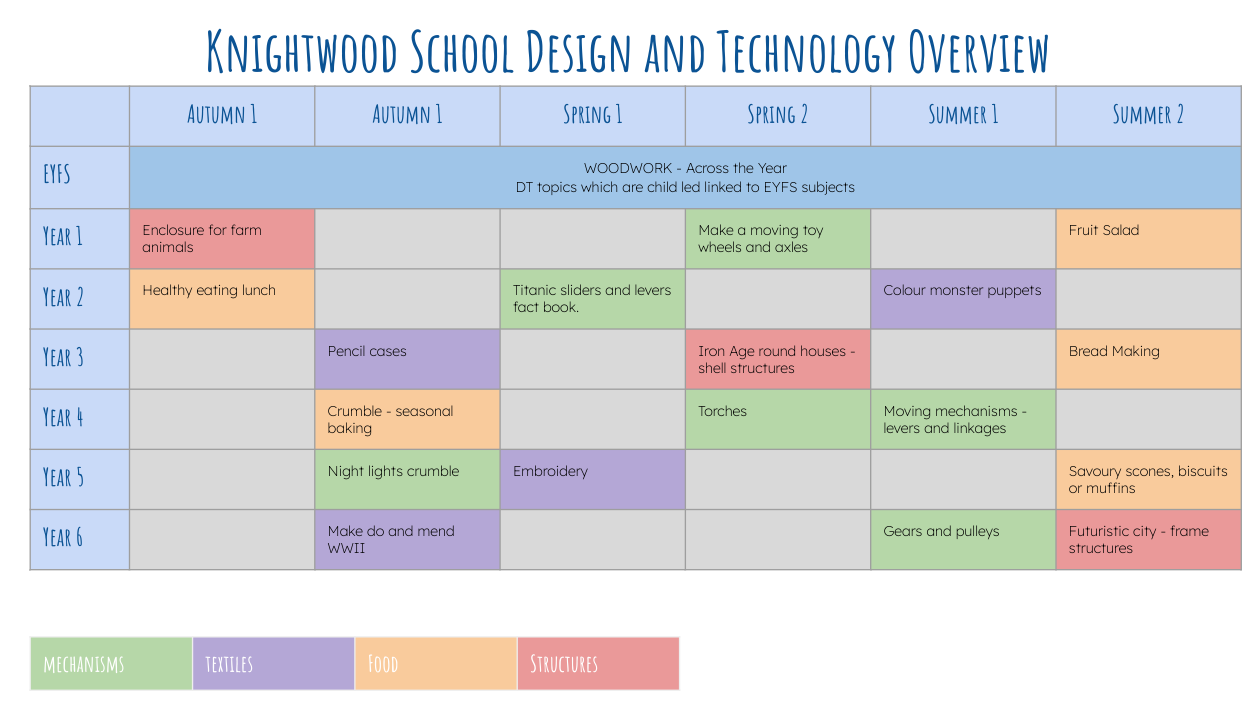Design & Technology
Our children will be innovative, creative and resourceful learners, equipped with the skills to solve real and relevant problems within a variety of contexts. They will consider their own and others’ needs, wants and values and be ambitious problem solvers who are not afraid of making mistakes. They will be confident in preparing food and understand the effect this has on our bodies.
Intent:
In an ever-changing world, children need the ability to think creatively, critically, and apply problem-solving skills in a practical way. The curriculum we aim to provide is to cultivate a passion for design, engineering, and innovation, enabling pupils to develop an understanding of how products and systems work. Furthermore, we aim to promote an awareness of the impact of design and technology on individuals, communities, and the environment. The children will be given opportunities to make products for real life consumers whilst ensuring there is a clear progression of skills as set out in the national curriculum. We foster an inclusive environment where pupils of all abilities are engaged and challenged, with opportunities to explore and develop their creativity and technical understanding.
Implementation:
A designer/engineer/chef plans and makes different products by researching, analysing, designing, testing and making things for a particular audience in mind.
Our project-based curriculum ensures that children get the opportunity to allow for meaningful exploration and application of knowledge and skills. All children will gain experience of structures, mechanisms, textiles, electrical circuits and food throughout their time at Knightwood. The children will progress through the school, experiencing a range of skills and opportunities that fit with the National Curriculum progression of skills. Each project builds towards children applying Design & Technology skills and understanding in a final, authentic product. Pupils are taught about influential designers, chefs and engineers in the fields that they study.
DT is integrated with other subjects, where cross-curricular opportunities are maximised to enrich learning experiences. The design process, including research, design, making, and evaluation, is explicitly taught and embedded in project-based activities, enabling pupils to apply their theoretical understanding to real-world contexts. Every unit will begin with a discovery box which gives children the opportunity to explore, think for themselves and create their own conclusions. They will then move onto investigative and evaluative activities which enables children to learn key vocabulary. This vocabulary will be applied through a focus task where children will have the opportunity to trial different techniques before the design process begins. Practical sessions are well-resourced, and the use of tools and materials is carefully supervised to ensure a safe and stimulating learning environment. Children will have experience of working with a range of resources and tools including wood, hacksaws, textiles, needles, card and craft knives. Within our projects, we foster natural links with computer programming and make use of our crumble kits, which help children bring their designs to life. Children are taught how to follow risk assessment and use resources safely.
High-quality teaching is a hallmark of effective DT provision, with teachers demonstrating subject expertise and enthusiasm for the subject. Effective differentiation and scaffolding enable all pupils, including those with SEND, to access the curriculum and make meaningful progress. Furthermore, pupils are encouraged to learn from both successful outcomes and productive failures, fostering a resilient and reflective approach to their design and making activities.
Impact:
Pupils will demonstrate a deepening understanding of key concepts and principles in DT, as well as a growing proficiency in practical skills and techniques. They are able to articulate their design decisions and evaluate their work with a critical eye, demonstrating clear progression in their ability to innovate, create, and problem-solve. Furthermore, the impact of the DT curriculum extends beyond individual pupil achievement. Pupils develop a profound appreciation for the role of design and technology in the world around them, understanding its cultural, social, and economic significance. They also exhibit values of respect, collaboration, and environmental sustainability through their design and making activities, reflecting the broader educational ethos of the school. The DT provision contributes to pupils’ preparedness for the next stage of their education, equipping them with essential skills for future learning and employment. It ensures that pupils leave primary school as confident, resourceful, and capable young designers and technologists, ready to embrace the challenges of an ever-evolving world.
